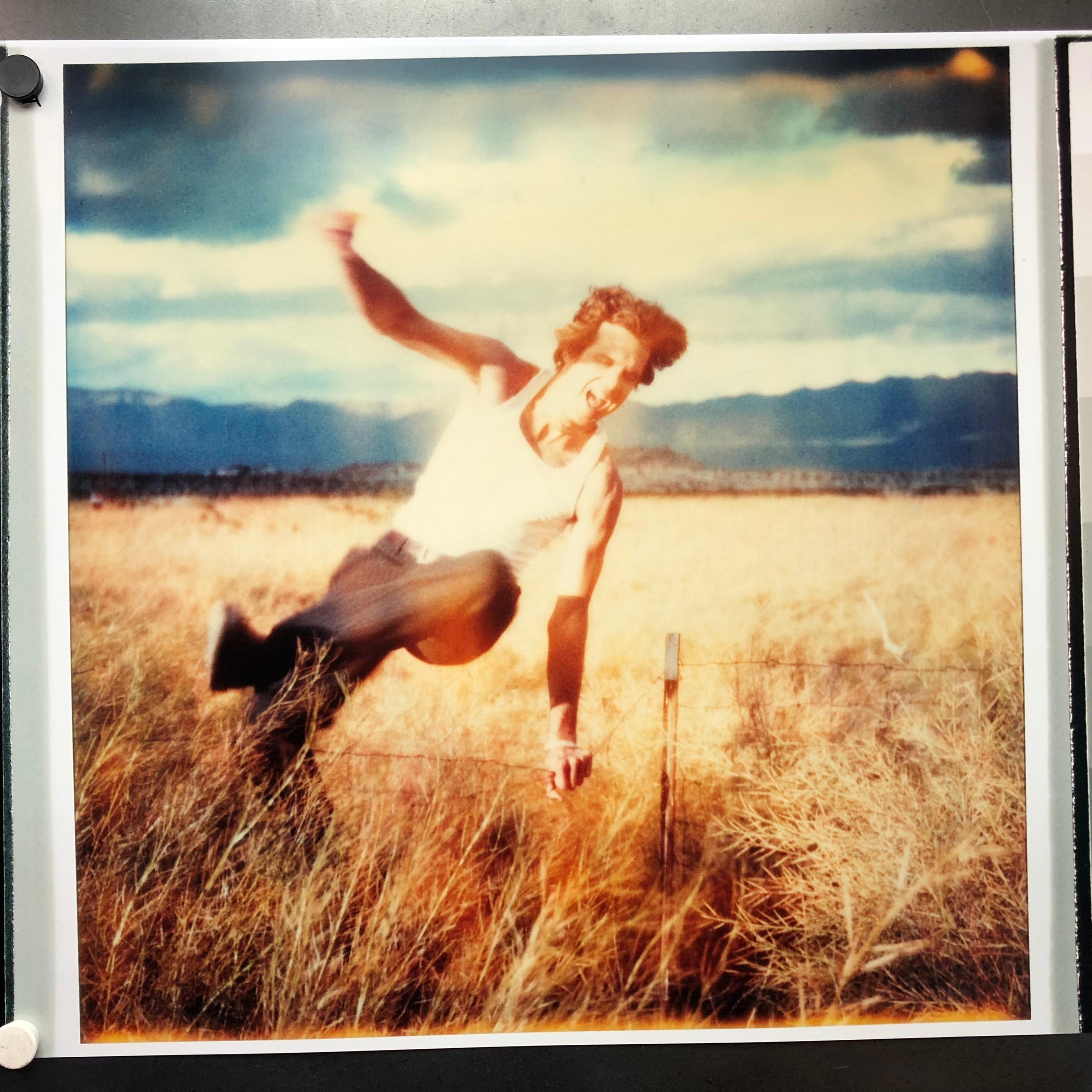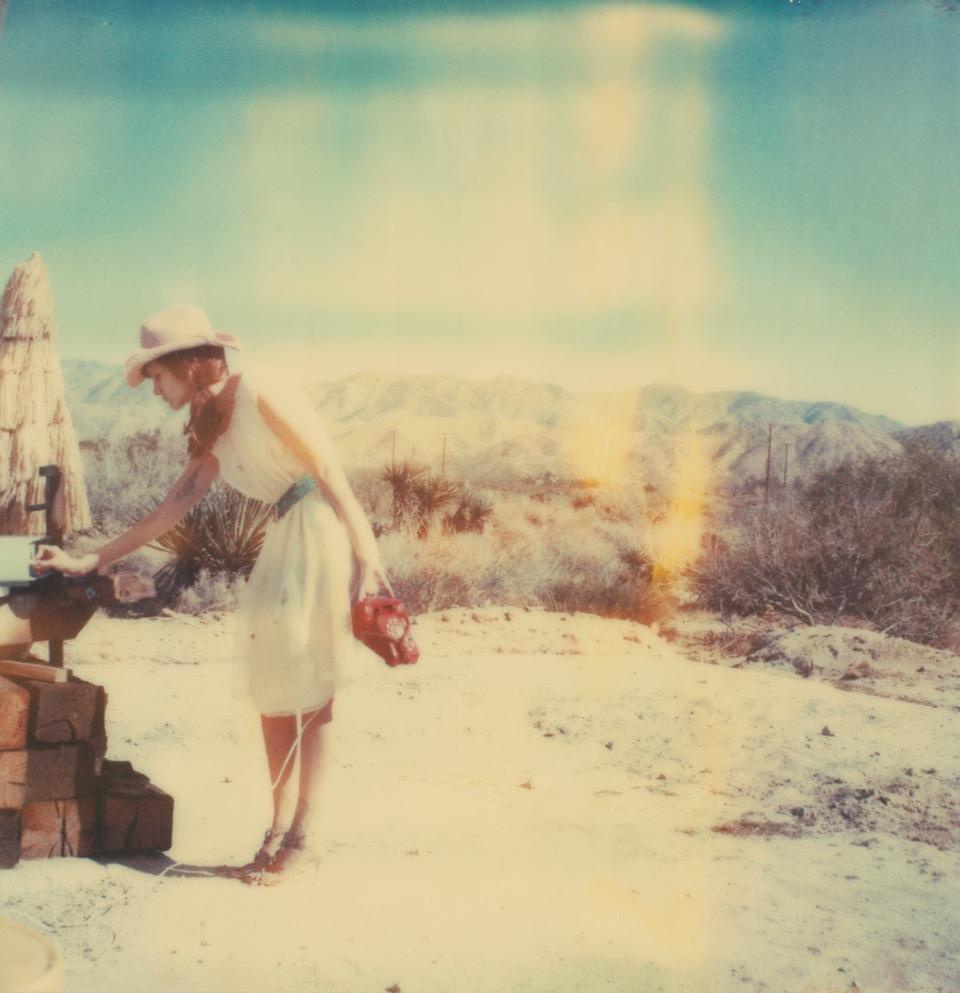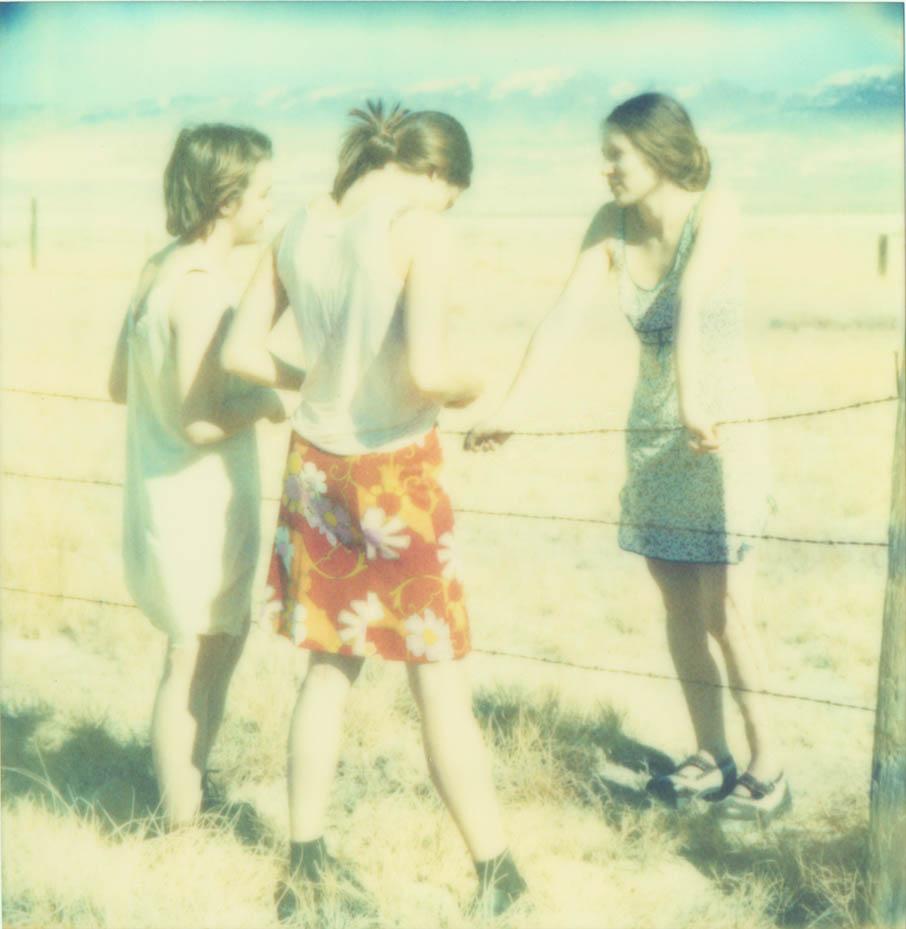Items Similar to Marilyn (Heavenly Falls) - triptych - mounted
Want more images or videos?
Request additional images or videos from the seller
1 of 14
Stefanie SchneiderMarilyn (Heavenly Falls) - triptych - mounted2016
2016
About the Item
Marilyn (Heavenly Falls) - triptych - mounted - 2016,
Edition 1/10,
38x37cm each, installed 38x120cm.
3 Lambda C-Prints, based on three original Polaroids.
Sandwiched in between Plexi Glass, matte surface.
Artist inventory number: 19485.01.
Signed on verso.
Stefanie Schneider interviewed for Instant Dreams Documentary
When did you first decide to work with Polaroids? Why do Polaroids seem to be so well-tuned to our (artistic) senses, perception and minds?
I started using expired Polaroid film in 1996. It has the most beautiful quality and encapsulates my vision perfectly. The colors on one hand, but then the magic moment of witnessing the image appear. Time seems to stand still, and the act of watching the image develop can be shared with the people around you. It captures a moment, which becomes the past so instantly that the decay of time is even more apparent; – it gives the image a certain sentimentality. The Polaroid moment is an original every time.
Why use a medium from the past?
For me, analog has always been there in the present. For the new generation, analog is interesting because it's new to them. I understand that people growing up in a digital age will wonder about its usefulness, but it's theirs to recover if they want to. When I first started working with Polaroid, it wasn't the past. It was a partially forgotten medium, but it existed nonetheless. It is mine by choice. There is no substitute for tangible beauty.
Is it imperfect?
The imperfect perfection in a “wabi-sabi” kind of way.
Wabi-sabi (侘寂) represents a comprehensive Japanese worldview or aesthetic centered on the acceptance of transience and imperfection. The aesthetic is sometimes described as one of beauty that is imperfect, impermanent, and incomplete.
'If an object or expression can bring about, within us, a sense of serene melancholy and a spiritual longing, then that object could be said to be wabi-sabi'. 'Wabi-sabi nurtures all that is authentic by acknowledging three simple realities: nothing lasts, nothing is finished, and nothing is perfect.'
Is the Polaroid photograph recognizable or even sometimes cliché?
Absolutely! There's something cliché about the way I'm showing the American Dream. I live it myself, trying to find perfection in an imperfect world. Reaching for the horizon. The dream is broken; the cliché tumbles. There are different ways to involve an audience. You could make movies like Harmony Korine's 'Gummo', a masterpiece in my view, which would estrange a large part of the audience. A certain film education is a prerequisite. Or you can start with clichés, the audience then feels safe, which lures them into the depth of your world without them even knowing it or understanding where exactly they are being led to. Appealing to emotions and the subconscious. Normal, Change, New Normal.
You continually revisit the landscape of the American West in your work. What draws you back to this scene?
Southern California represents a dream to me. The contrast of Northern Germany, where I grew up, to the endless sunshine of Los Angeles was what first attracted me. The American West is my dream of choice. Wide, open spaces give perspectives that articulate emotions and desires. Isolation feeds feelings of freedom or sometimes the pondering of your past. The High Desert of 29 Palms has very clear and vivid light, which is vital. Expired Polaroid film produces 'imperfections' that I would argue mirrors the decline of the American dream. These so-called 'imperfections' illustrate the reality of that dream turning into a nightmare. The disintegration of Western society.
Are you playing with the temporality of the material and the value of the moment itself?
The value of the moment is paramount, for it is that moment that you're trying to transform. All material is temporary, it's relative, and time is forever.
Why does analog film feel more pure and intuitive?
It's tangible and bright and represents a single moment.
The digital moment may stay in the box (the hard drive / camera / computer etc.) forever, never to be touched, put into a photo album, sent in a letter, or hung on a wall.
Printing makes it an accomplishment.
The analog world is more selective, creating images of our collective memory.
The digital worldwide clicking destroys this moment. The generation without memories due to information overload and hard drive failures. Photo albums are a thing of the past.
Why does it feel this way?
That's how the human instinct works.
When I was a child, every picture taken was a special moment. Analog photographic film as well as Super-8 material were expensive treasures. My family's memories were created by choosing certain moments in time. There was an effort behind the picture. The roll of film might wait months inside the camera before it was all used. From there, the film required developing, which took more time, and finally, when the photos were picked up from the shop, the memories were visited again together as a family. Who knew then, how fleeting these times were. Shared memories were a ritual.
What's your philosophy behind the art of Polaroid pictures?
The 'obsolete' is anything but obsolete. Things are not always as they appear, and there are hidden messages. Our memories and our dreams are under-valued. It is there that real learning and understanding begins by opening yourself to different perspectives.
What inspired you to use stop-motion cinematography?
My work has always resembled movie stills. I remember the first time I brought a box of Polaroids and slid them onto Susanne Vielmetter's desk (my first gallery). Instantly, it became apparent that there was a story to tell. The stories grew. It was undeniable to me, that the emerging story was where I was destined to go. I've made four short films before my latest feature film, The Girl behind the White Picket Fence. This film is 60 minutes long with over 4000 edited Polaroids. It's important to remember that our sub-conscious fills in the blanks, the parts missing from the story allow a deeper and more personal experience for the viewer. That is, if you surrender yourself and trust me as the director to lead you somewhere you might not have been before.
Why do you think it is important to own art?
'We have art in order not to die of the truth' - Nietzsche
- Creator:Stefanie Schneider (1968, German)
- Creation Year:2016
- Dimensions:Height: 14.97 in (38 cm)Width: 47.25 in (120 cm)Depth: 0.4 in (1 cm)
- Medium:
- Movement & Style:
- Period:
- Condition:
- Gallery Location:Morongo Valley, CA
- Reference Number:
Stefanie Schneider
Stefanie Schneider received her MFA in Communication Design at the Folkwang Schule Essen, Germany. Her work has been shown at the Museum for Photography, Braunschweig, Museum für Kommunikation, Berlin, the Institut für Neue Medien, Frankfurt, the Nassauischer Kunstverein, Wiesbaden, Kunstverein Bielefeld, Museum für Moderne Kunst Passau, Les Rencontres d'Arles, Foto -Triennale Esslingen., Bombay Beach Biennale 2018, 2019.
About the Seller
4.9
Platinum Seller
These expertly vetted sellers are 1stDibs' most experienced sellers and are rated highest by our customers.
Established in 1996
1stDibs seller since 2017
955 sales on 1stDibs
Typical response time: 4 hours
- ShippingRetrieving quote...Ships From: Morongo Valley, CA
- Return PolicyA return for this item may be initiated within 7 days of delivery.
More From This SellerView All
- Field of Dreams (Sidewinder), analog, 80x78cm, Edition 2/5By Stefanie SchneiderLocated in Morongo Valley, CAField of Dreams (Sidewinder) - 2005 80 x 78 cm, Edition of 5, analog C-Print, hand-printed by the artist, based on the Polaroid, Artist Inventory 3131.02, Not mounted Stefanie ...Category
Early 2000s Contemporary Figurative Photography
MaterialsPhotographic Paper, Archival Paper, C Print, Color, Polaroid
- Ewan McGregor - Contemporary, 21st Century, Polaroid, Figurative PhotographyBy Stefanie SchneiderLocated in Morongo Valley, CA'Ewan McGregor' (Stay) - 2006 20x20cm, Edition of 10, Archival C-Print, based on the Polaroid Certificate and Signature label artist Inventory No. 5007.01 Not mounted Stefanie Schneider: Torsten Scheid, “Fotografie, Kunst, Kino. Revisited.”, FilmDienst 3/2006, page 11-13 Photography Art Cinema. Revisited Stay expands a traditional connection through new facets Interwoven between the media of photography and film is a veritable mesh-work of technical, motific, metaphorical and personal interrelationships. Extending from photo-film which, as in La Jetée by Chris Marker (France, 1962) is a montage of single, unmoving photographs all the way to the portrayal of photographic motifs in Hollywood cinema―most recently in Memento (USA, 2000) and One hour photo (USA, 2002)―is the range of filmic-photographic interactions on the one hand, and from the adaption of modes of cinematic production to the imitation of film stills on the other. For instance, with the legendary Untitled Film Stills (1978) of the American artist Cindy Sherman, who later made her debut as a film director with Office Killer (USA, 1997) and thereby, like many others, changed sides: Wim Wenders, Robert Frank and Larry Clark are doubtlessly the most successful of these photographic-filmic border crossers. This brief survey provides only a vague indication of the dimensions of this intermedial field, which in fact extends much further and is constantly being cultivated. Also as a motif in film, photography has experienced a historical transformation: Photographers were once considered to be technicians who mastered a craft but never achieved the status of artists. Photographer-figures were caught in the allure of beautiful appearance, incapable of penetrating to the actual essence of things. Such depth was reserved for literature or painting. When photography in film touched upon the sphere of art, then most often as its contrasting model, as the metaphor for a superficial access to the world. Coming to mind are Fred Astaire as a singing fashion photographer in Stanley Donen’s musical film Funny Face (USA, 1957), or the restless lifestyle-photographer in Michelangelo Antonioni’s genre-classic Blow up (GB, 1966). For the doubting Thomas...Category
Early 2000s Contemporary Landscape Photography
MaterialsArchival Paper, Photographic Paper, C Print, Color, Polaroid
- Gasoline II, triptych - Stranger than Paradise - Sold out Edition of 5, AP 1/2By Stefanie SchneiderLocated in Morongo Valley, CAGasoline II (Stranger than Paradise) 1999 - 3 pieces, each 128x125cm, installed 125x295cm including gaps. sold out Edition of 5, Artist Proof 1/2 Analog C-Prints, hand-printed by...Category
1990s Contemporary Landscape Photography
MaterialsArchival Paper, Photographic Paper, C Print, Color, Polaroid
- Memories of Love II - Contemporary, 21st Century, Polaroid, Figurative, WomanBy Stefanie SchneiderLocated in Morongo Valley, CAMemories of Love II (The Girl behind the White Picket Fence) - 2013 20x20cm, Edition of 10, plus 2 Artist Proofs. Archival C-Print, based on the Polaroid, Certificate and signatur...Category
2010s Contemporary Figurative Photography
MaterialsArchival Paper, Photographic Paper, C Print, Color, Polaroid
- Memories of Love - 21st Century, Polaroid, Figurative, Women, ColorBy Stefanie SchneiderLocated in Morongo Valley, CAMemories of Love (The Girl Behind the White Picket Fence) - 2013 Edition of 5 plus 2 Artist Proofs, 128x125cm. Analog C-Print, hand-printed by the artist based on the Polaroid. ...Category
2010s Contemporary Figurative Photography
MaterialsArchival Paper, Photographic Paper, C Print, Color, Polaroid
- Three Girls II (The Last Picture Show)By Stefanie SchneiderLocated in Morongo Valley, CAThree Girls II (The Last Picture Show) - 2006, 50x49cm, Edition of 10 plus 2 Artist Proofs. Archival C-Print, based on the original Polaroid. Certificate and Signature label. ...Category
Early 2000s Contemporary Landscape Photography
MaterialsPhotographic Paper, C Print, Color, Polaroid, Archival Paper
You May Also Like
- Dream - underwater photography, archival metallic paper contemporary mountedBy Kathleen WilkeLocated in Dallas, TXBeautiful woman floating in water wearing pink gown. "Sleep Me a Dream" is underwater photography created by Katheeen Wilke. C Print on Fuji Pe...Category
2010s Contemporary Figurative Photography
MaterialsPhotographic Paper, Plexiglass
- "Feather" - underwater photography, metallic pearlpaper contemporary mountedBy Kathleen WilkeLocated in Dallas, TX"Feather" is an underwater female swimmer with red hair, dropping a yellow feather. C Print on Fuji Pearl, Perspex mounted 30H x 32L x 1W inches Edition of 10 Kathleen Wilke blurs the lines of poetry and fiction through her underwater photography...Category
2010s Contemporary Figurative Photography
MaterialsPhotographic Paper, Plexiglass
- Basketball 1, Clapham, Samuel Hicks - Figurative Photography, Landscape PhotoBy Samuel HicksLocated in Brighton, GBPlease bear in mind that all prints are produced to order and lead times are expected between 15-20 days. Basketball, Clapham I is a stunning C-Type Print by contemporary photograph...Category
21st Century and Contemporary Contemporary Figurative Photography
MaterialsPhotographic Paper, C Print, Digital
- Bolonia 3, Rosa Basurto - Contemporary Photography, Beach, Landscape, SandBy Rosa BasurtoLocated in Brighton, GBPlease bear in mind that all prints are produced to order. Lead times are expected between 15-20 days. This is an 80cm x 80cm Digital print on 100cm x 100cm Cotton Paper. This sized...Category
21st Century and Contemporary Contemporary Landscape Photography
MaterialsDigital, C Print, Photographic Paper
- Hong Kong Football, Chris Frazer Smith - Contemporary Photography, SportsBy Chris Frazer SmithLocated in Brighton, GBPlease bear in mind that all prints are produced to order and lead times are between 15-20 days. Hong Kong Football is a dynamic C-Type Matte Print by Contemporary photographer Chri...Category
21st Century and Contemporary Contemporary Figurative Photography
MaterialsPhotographic Paper, C Print, Color
- Youth II by Ben ThomasLocated in Brighton, GBPlease bear in mind that all prints are produced to order. Lead times are expected between 15-20 days. Due to currency fluctuations prices may change. Youth II is a stunning C-Type Print by contemporary photographer Ben Thomas...Category
21st Century and Contemporary Contemporary Landscape Photography
MaterialsPhotographic Paper, Color, C Print





